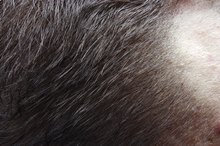What does fact checked mean?
At Healthfully, we strive to deliver objective content that is accurate and up-to-date. Our team periodically reviews articles in order to ensure content quality. The sources cited below consist of evidence from peer-reviewed journals, prominent medical organizations, academic associations, and government data.
The information contained on this site is for informational purposes only, and should not be used as a substitute for the advice of a professional health care provider. Please check with the appropriate physician regarding health questions and concerns. Although we strive to deliver accurate and up-to-date information, no guarantee to that effect is made.
Hair Loss Due to Malnutrition
Hair loss affects both men and women and is not restricted to aging individuals. One cause of hair loss is malnutrition 1. Hair loss indicates a nutritional deficit, and both hair loss and malnutrition are often symptoms of an underlying serious mental or physical health concern.
The Hair-Growth Cycle
The normal, healthy hair-growth cycle is two to six years, and hair grows consistently during this phase, followed by a rest phase and, finally, a shedding phase, when old hair is replaced by new hair. According to FamilyDoctor.org, approximately 90 percent of hair on the scalp is growing at any one time. On its Web page, the Mayo Clinic indicates that the average healthy person sheds 50 to 100 hairs per day. The growth process can be easily interrupted by external and internal factors, from cosmetic procedures to illness and medication. Malnutrition takes many forms and often leads to excessive hair loss, which can be reversed, in many cases, if appropriate measures are taken to diagnose and address the underlying malnourishment.
- The normal, healthy hair-growth cycle is two to six years, and hair grows consistently during this phase, followed by a rest phase and, finally, a shedding phase, when old hair is replaced by new hair.
- The growth process can be easily interrupted by external and internal factors, from cosmetic procedures to illness and medication.
Symptoms
The Causes of Brittle Nails and Slow-Growing Hair
Learn More
Hair loss is generally a straightforward problem. However, different patterns of hair loss can mean different things. Receding hairlines in men and women are related to genetics and aging, and sudden widespread thinning happens after chemotherapy. More subtle thinning that seems to be an acceleration of the normal hair-shedding process is the type associated with malnutrition.
- Hair loss is generally a straightforward problem.
- Receding hairlines in men and women are related to genetics and aging, and sudden widespread thinning happens after chemotherapy.
Causes
There are countless causes of malnutrition. Some common ones associated with hair loss are eating disorders (undereating or overeating), poor diet (lack of protein, crash diets or drastic weight loss), anemia (iron, zinc, etc.), too much vitamin A, thyroid diseases, diabetes, lupus and a variety of medical treatments, including chemotherapy and radiation.
Why does it result in hair loss?
B6 & Zinc Hair Loss Treatment
Learn More
The hair-growth process is tied to hormone levels and certain nutrients. Malnutrition can throw multiple body systems into states of chemical imbalance. Too little protein (an essential building block of hair) or too much vitamin A, even too much stress, can upset the balance that allows the hair-growth cycle to proceed normally.
Treatment options
If the cause of malnutrition is unknown or not clinically obvious, blood tests should be done to determine the nutrients that are lacking. A dermatologist can also take a medical history and perform tests and examinations to rule out other causes of hair loss.
Once causes are determined, supplements or dietary modification can be undertaken to remedy the specific type of malnourishment and balance out nutrient levels. In cases of malnutrition-induced hair loss, this should reverse the effects. Additionally, prenatal or other high-dose vitamins can be prescribed to help boost the body’s supply of the deficient nutrient(s).
If malnutrition and subsequent hair loss are due to an eating disorder, behavior modification and therapy should be implemented to insure the long-term health of the individual.
- If the cause of malnutrition is unknown or not clinically obvious, blood tests should be done to determine the nutrients that are lacking.
- Once causes are determined, supplements or dietary modification can be undertaken to remedy the specific type of malnourishment and balance out nutrient levels.
Prognosis
Many of the commonly listed causes for hair loss related to malnutrition are either reversible or manageable. While not all hair loss can be reversed, hair loss due to malnutrition generally ceases when the deficiency is corrected. Hair loss can also be a symptom of an underlying disease, such as diabetes and lupus. Underlying diseases cause stress to the body and may cause malnutrition, which in turn causes hair loss. But these may only be the early signals of a more severe illness, so it is important to pay attention to these symptoms.
- Many of the commonly listed causes for hair loss related to malnutrition are either reversible or manageable.
- Underlying diseases cause stress to the body and may cause malnutrition, which in turn causes hair loss.
Related Articles
References
- Family Doctor Health Information Resource: Hair Loss and its Causes
- Aging SkinNet Article: What Causes Hair Loss?
- MayoClinic reprints: Hair Loss
- Fabbrocini G, Cantelli M, Masarà A, Annunziata MC, Marasca C, Cacciapuoti S. Female pattern hair loss: A clinical, pathophysiologic, and therapeutic review. Int J Womens Dermatol. 2018;4(4):203-211. doi:10.1016/j.ijwd.2018.05.001
- Mirmirani P. Managing hair loss in midlife women. Maturitas. 2013;74(2):119-22. doi:10.1016/j.maturitas.2012.10.020
- Trost LB, Bergfeld WF, Calogeras E. The diagnosis and treatment of iron deficiency and its potential relationship to hair loss. J Am Acad Dermatol. 2006;54(5):824-44. doi:10.1016/j.jaad.2005.11.1104
- Park SY, Na SY, Kim JH, Cho S, Lee JH. Iron plays a certain role in patterned hair loss. J Korean Med Sci. 2013;28(6):934-8. doi:10.3346/jkms.2013.28.6.934
- Guo EL, Katta R. Diet and hair loss: effects of nutrient deficiency and supplement use. Dermatol Pract Concept. 2017;7(1):1-10. doi:10.5826/dpc.0701a01
- Vincent M, Yogiraj K. A Descriptive Study of Alopecia Patterns and their Relation to Thyroid Dysfunction. Int J Trichology. 2013;5(1):57-60. doi:10.4103/0974-7753.114701
- Davis SR, Castelo-branco C, Chedraui P, et al. Understanding weight gain at menopause. Climacteric. 2012;15(5):419-29. doi:10.3109/13697137.2012.707385
- Gupta AK, Charrette A. Topical Minoxidil: Systematic Review and Meta-Analysis of Its Efficacy in Androgenetic Alopecia. Skinmed. 2015;13(3):185-9.
- American Academy of Dermatology. Thinning hair and hair loss: Could it be female pattern hair loss?
- Harvard Health Publications. Treating female pattern hair loss - Harvard health.
- U.S. National Library of Medicine. Female pattern baldness.
Writer Bio
A.G. Watson holds a B.A. in liberal arts with a focus on photography and anthropology. Excerpts from her thesis project were recently published in Claremarket Review. As an artist/musician working as a medical editor, Watson has a wide range of interests and knowledge that are ideal for creative, informational writing services.








